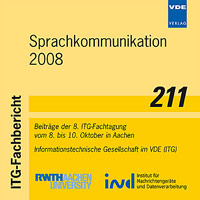Exploiting the Self-Steering Capability of Blind Source Separation to Localize Two or More Sound Sources in Adverse Environments
Conference: Sprachkommunikation 2008 - 8. ITG-Fachtagung
10/08/2008 - 10/10/2008 at Aachen, Germany
Proceedings: Sprachkommunikation 2008
Pages: 4Language: englishTyp: PDF
Personal VDE Members are entitled to a 10% discount on this title
Authors:
Lombard, Anthony; Rosenkranz, Tobias (Multimedia Communications and Signal Processing, University of Erlangen-Nuremberg, Cauerstr. 7, 91058-Erlangen, Germany)
Buchner, Herbert (Deutsche Telekom Laboratories, Technical University Berlin, Ernst-Reuter-Platz 7, 10587-Berlin, Germany)
Abstract:
Blind Source Separation (BSS) algorithms have often been interpreted as a set of blind adaptive beamformers. Although this interpretation does not entirely hold under realistic conditions, it gives some useful insights on the self-steering capacity of BSS techniques. Actually, while accurate source location information is usually necessary to steer a beamformer, BSS offers the possibility to recover the original source signals from a reverberant sound mixture without this prior knowledge. Intuitively, this self-steering capacity should therefore imply that the BSS demixing filters contain some useful information on the location of each source. In this paper, we discuss the relations between BSS and beamforming techniques, based on the general form of the ideal separation solution. Two possible ways to extract the location information from the BSS demixing system are then presented. Experiments using a broadband BSS algorithm based on the TRINICON framework demonstrate the efficiency of the proposed methods in a highly reverberant and noisy environment, for up to six simultaneously active speech sources.


